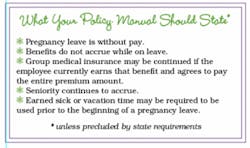She couldn’t wait to tell you the news. “I wanted to share my good news with you,” she said. “I’m pregnant!”
With women making up the lion’s share of dental teams today, dentists have probably heard this announcement a time or two. How they respond and handle the situation could set them up for potential liabilities, including financial loss.
Like most doctors, you may not be familiar with the federal and state laws that prohibit discrimination on the basis of pregnancy, childbirth, and medical conditions related to pregnancy. Dentists often learn about these complicated regulations the hard way - via labor board complaints or lawsuits.
For example, take the pregnant team member who went on maternity leave from one practice. When she did not return to work at the end of the legally required time off for a maternity leave, the doctor hired a replacement. Three months later when she informed the doctor of her desire to return to work, the job was no longer available. She sued for pregnancy discrimination - and won.
The court ruled in the employee’s favor because the doctor had failed to inform her of the date on which the maternity leave was to end. Had that date been specified in writing, her failure to return by that date would have constituted a resignation. The doctor had to pay three months’ back wages plus penalties - a total of $7,600.
It's the law
Many dental practices are subject to the Pregnancy Discrimination Act (PDA). In general terms, this federal law is applicable to employers with 15 or more full-time, part-time, and temporary employees. But to complicate matters, several states have implemented their own pregnancy regulations, some with stricter terms. In California, for example, the law applies to employers with five or more employees.
The PDA declares it unlawful to deny employment or promotion, or to fire a woman because she is pregnant. Employees with pregnancy-related disabilities must be treated the same as employees with temporary disabilities.
Under the law, dentists can request that mothers-to-be give reasonable notice about the beginning date of their maternity leaves. Reasonable notice is usually defined as at least 30 days before the start of the leave. We also suggest requesting written verification by the employee’s physician about the approximate delivery date and if there are any restrictions, such as she can only work five hours a day.
Pregnancy disability leave
A pregnancy disability leave may begin when, in the opinion of her physician or other licensed health-care practitioner, the pregnant employee is unable to perform the essential duties of her job, or to perform those duties without undue risk to her or others, and accommodation is not feasible. The leave need not be taken at one time. For example, it could consist of a brief leave at the beginning of the pregnancy, and the rest could be taken later, during or after the pregnancy.
The recommended length of the disability leave is up to four weeks for a normal pregnancy and up to three months if there are medical complications related to the pregnancy. However, several states have instituted specific requirements regarding the length of pregnancy leave. For example, California employees must be given up to four months for a pregnancy-related disability leave. At a minimum, employees must be given the same length of leave for a pregnancy that is allowed for other disability leaves, if it is longer than state requirements. (Employers covered by the Family Medical Leave Act, those with 50 or more employees, are required to provide up to 12 weeks of disability leave.)
Considerations
With the high percentage of women in today’s work force, pregnancy is a common occurrence. As noted above, not handling pregnancy leave correctly can have significant financial consequences.
Although you may not be legally required to provide pregnancy leave pursuant to applicable state or federal law, by providing this employee benefit you ensure being competitive in the marketplace and better protected from discrimination claims. Be sure your staff policy manual states the length of leave you provide.
As a general rule, a pregnant woman’s job must be held open for her return. This is defined as a similar position with the same level of authority, number of hours, and pay, unless the job is no longer available due to legitimate business reasons.
Several basic steps should be followed in handling pregnancy leave:
1 Immediately after being informed of the pregnancy, ask the employee to review the information in your Staff Policy Manual regarding pregnancy leave.
2 Ask her to provide a physician’s written statement with the approximate delivery date and any restrictions regarding her ability to fulfill her essential duties. Have her provide the physician with a copy of her Americans with Disabilities Act compliant job description (call our office for information on obtaining ADA compliant job descriptions).
3 Ask her to sign a “Health Hazards During Pregnancy Release Letter” (call our office for a sample if you don’t have one) which acknowledges in part:
• The potential health hazards of continued work
• Her right to request the accommodation of another position (the employer should not move her to another position without her request)
• That by continuing employment she assumes responsibility for any possible harm to herself or the baby
4 If the employee is unable to perform certain work functions and the employer is unable to accommodate her with another work assignment, it may be an option to immediately put her on unpaid pregnancy disability leave (check with our office or your employment law specialist first).
5 Ascertain her plans for returning to work and document leave starting and ending dates. While on leave she should be required to report every 30 days regarding her continued intention to return to work.
This information provides some answers to a delicate and potentially costly situation if mishandled.
In the future when you hear the joyful news “I’m pregnant,” you can now say, “Congratulations! Let’s meet to discuss a few issues regarding these next few months on the job.” By following the steps above, everyone wins - the mother-to-be, the baby, and your business. ■
Tim Twigg
Mr. Twigg is president of Bent Ericksen and Associates, a firm helping dentists with human resources and personnel issues. He is a member of the Academy of Dental Management Consultants and the National Speakers Association. To receive a complimentary copy of the company¿s quarterly newsletter, call (800) 679-2760 or visit www.bentericksen.com.








